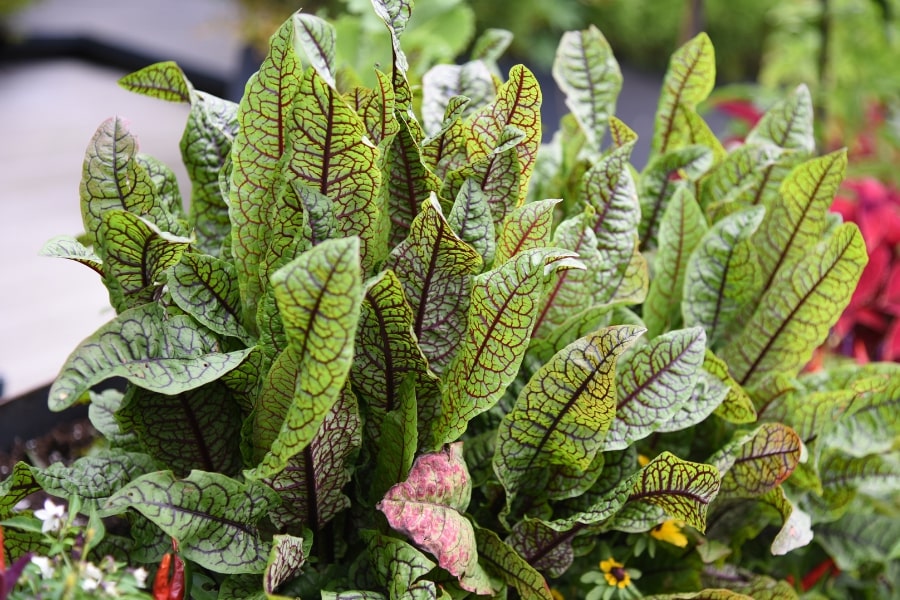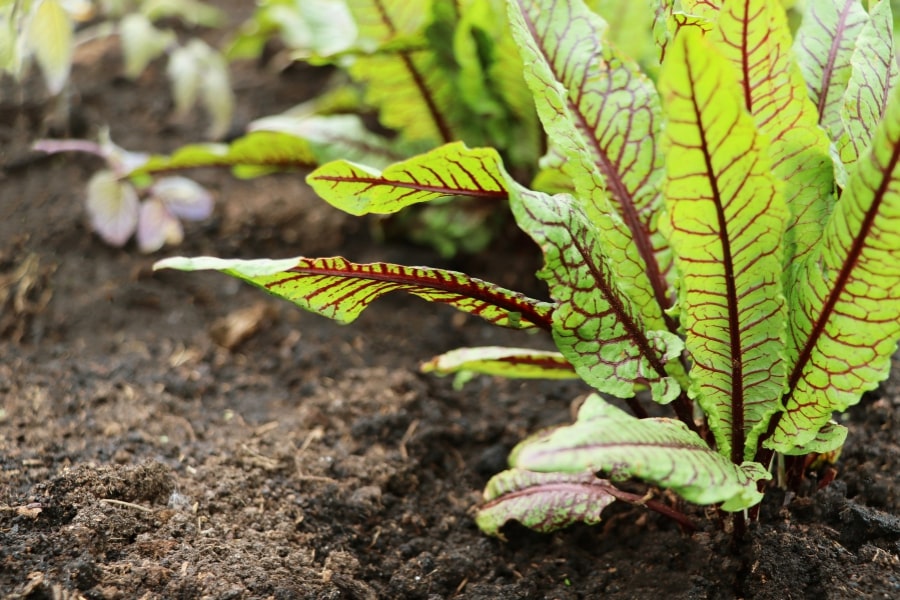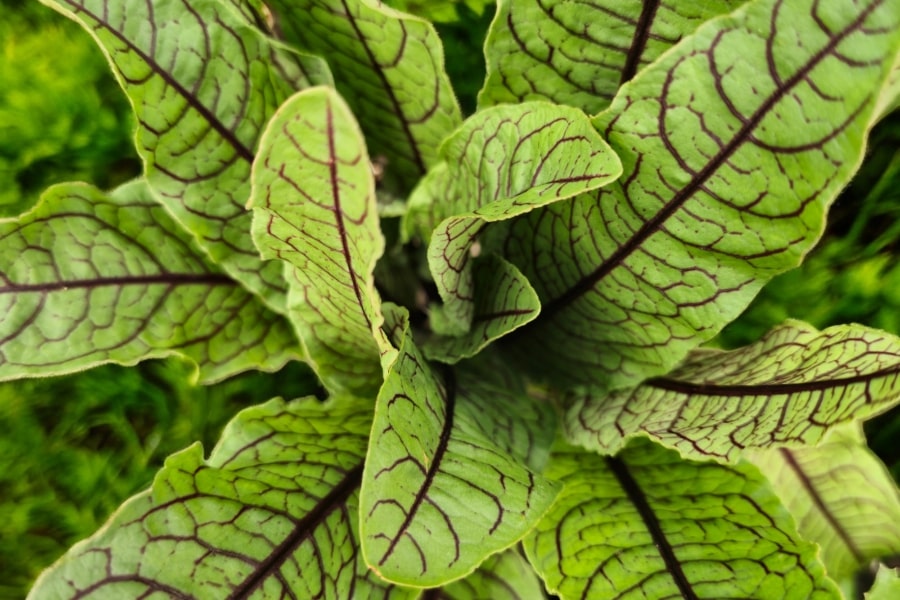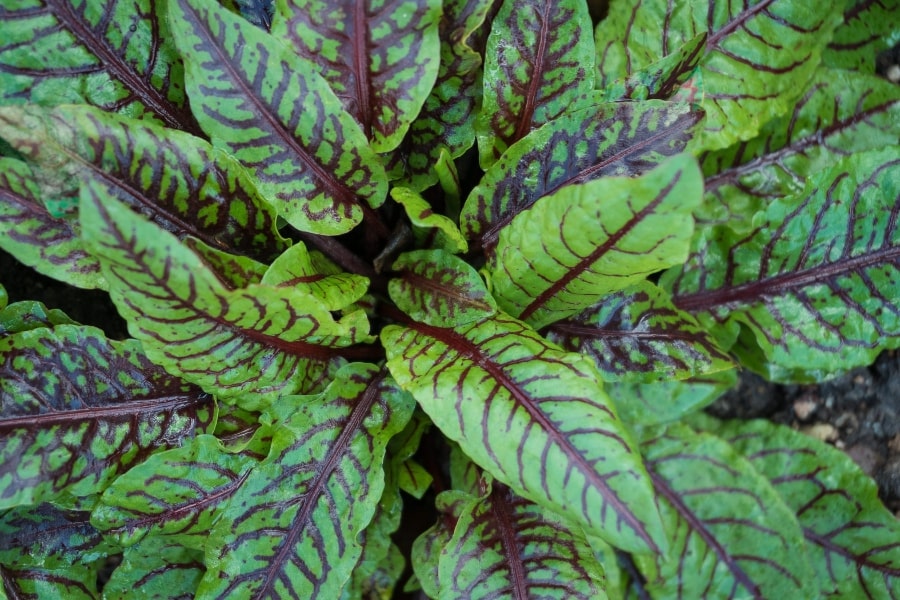Rumex, commonly known as Red Vein Dock or Sorrel, is a genus of plants that belong to the family Polygonaceae. These evergreen perennials typically grow in clumps or rosettes and have vibrant red veins and striking foliage. Their elongated leaves, ranging from deep green to reddish-green, create an eye-catching display in gardens and landscapes.

Our Selection of Rumex
At Martin Garden Center, we try to stock Rumex year-round in 4″ containers, as our vendors tend to grow it year-round and, just a reminder, it is a beautiful evergreen.
Growing and Caring For Rumex
Most Rumex species prefer full to partial sun. Ample sunlight promotes healthy growth and foliage development. It also contributes to the production of flavorful leaves in culinary varieties. While some Rumex species can tolerate light shade, providing sufficient sunlight is essential for optimal performance and vitality.
Well-draining soil is a key factor in creating favorable conditions for Rumex. These plants appreciate soil that allows excess moisture to drain away, preventing waterlogged roots and potential fungal issues. Amending the soil with compost or organic matter helps improve drainage and soil structure, providing a nutrient-rich environment for robust growth. While Rumex can tolerate a range of soil types, maintaining soil pH levels around neutral (pH 6.0 to 7.0) is generally suitable for their cultivation.
Rumex needs consistent moisture, but it’s important to strike a balance to avoid overwatering. Water deeply when the top inch of soil feels dry, and ensure the soil has good drainage. Proper watering practices contribute to healthy growth and leaf production, especially in culinary varieties where the leaves are prized for their tangy flavor. Applying mulch around Rumex plants helps conserve soil moisture, suppress weed growth, and maintain a more stable soil temperature, enhancing their overall well-being.
Rumex can benefit from occasional fertilization to promote healthy growth, but excessive fertilizer application should be avoided. Pruning or deadheading the flowers of Rumex is not necessary for the plant’s overall health, but it can help maintain a neat appearance. If desired, spent flower stalks can be removed to prevent self-seeding and redirect energy toward foliage growth.
It’s important to note Rumex, while evergreen in Upstate South Carolina, does benefit from being cut back time to time to spur regrowth of its beautiful leaves that, as they age, may get rust or leaf spot. Note that while Rumex is susceptible to rust, it does not deleteriously affect the plant’s health and can actually enhance the leaf color.

Leaves and Flowers
Rumex leaves are typically lance-shaped or arrowhead-like, varying in size depending on the specific Rumex species. One notable feature is their vibrant green color, which contrasts the garden or natural landscape. The leaves often have a tangy or sour taste, a trait that adds culinary significance to certain varieties of Rumex.
The flowers of Rumex are relatively inconspicuous, typically arranged in panicles or clusters on tall, slender stems that rise above the foliage. The small, greenish or reddish flowers lack the showiness of some ornamental plants, but they play a crucial role in the plant’s reproductive cycle. Rumex is known for its dioecious nature, meaning male and female flowers are found on separate plants.

Rumex is a versatile addition to the garden, offering both ornamental beauty and practical benefits. Its striking foliage, which ranges from deep green to rich red-veined leaves, makes it an excellent choice for mixed borders, cottage gardens, or as an accent in perennial beds. The bold texture and upright growth habit of Rumex pair well with Ornamental Grasses, Echinacea, and other structural plants, adding depth and contrast to planting schemes. It also thrives in rain gardens and damp soil areas where other plants may struggle, making it a great problem-solver for tricky garden spots.
Rumex can also serve a functional role in edible gardens, as varieties like French sorrel provide tangy, lemon-flavored leaves that are perfect for salads and soups. Its deep taproot helps improve soil structure by breaking up compacted earth, making it useful in permaculture and regenerative gardening. When planted alongside vegetables, it can act as a companion plant, attracting beneficial insects while deterring some pests.

Frequently Asked Questions
Is Red Vein Dock (Rumex) a Perennial or Annual?
Red Vein Dock, also known as Rumex or Sorrel, is a hardy perennial that returns year after year. It thrives in USDA zones 4-8 and can tolerate a wide range of growing conditions, from full sun to partial shade. While it may die back in colder Winters, it will regrow in Spring, often spreading through both self-seeding and its deep taproot.
Is Red Vein Dock Edible?
Yes, Red Vein Dock is edible and has a tangy, lemony flavor. Its young leaves are tender and can be used fresh in salads, while mature leaves are often cooked like spinach or added to soups and sauces. However, like other sorrel plants, it contains oxalic acid, which can be harmful in large quantities, so it should be eaten in moderation, especially by those with kidney concerns.
Do Deer Eat Red Vein Dock?
Red Vein Dock is generally deer-resistant due to its slightly bitter, tangy taste, which makes it less appealing to browsing animals. It also has natural pest resistance, though slugs and snails may occasionally feed on its leaves in wet conditions. It can be a great companion plant in vegetable gardens, helping to deter certain pests while supporting pollinators. Overall, it’s a hardy and low-maintenance plant with few pest issues.
